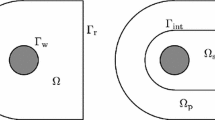Abstract
Reduced basis methods for the approximation to parameter-dependent partial differential equations are now well-developed and start to be used for industrial applications. The classical implementation of the reduced basis method goes through two stages: in the first one, offline and time consuming, from standard approximation methods a reduced basis is constructed; then in a second stage, online and very cheap, a small problem, of the size of the reduced basis, is solved. The offline stage is a learning one from which the online stage can proceed efficiently. In this paper we propose to exploit machine learning procedures in both offline and online stages to either tackle different classes of problems or increase the speed-up during the online stage. The method is presented through a simple flow problem—a flow past a backward step governed by the Navier Stokes equations—which shows, however, interesting features.










Similar content being viewed by others
Notes
Note, however, that this does not imply that numerical methods are not worthy as they can lead to new solutions and also are able to be connected to optimization or control algorithms based on mathematical concepts.
From now on, we restrict our attention to the velocity field. The same discussion can be extended to the pressure field.
Remember that this Piola transformation preserves the incompressibility condition satisfied by the velocity field.
Note that in this paper regression trees have been chosen because it is a classical regressor, but any other regressor could have been used.
References
Almroth BO, Stern P, Brogan FA (1978) Automatic choice of global shape functions in structural analysis. AIAA J 16(5):525–528
Cagniart N, Maday Y, Stamm B (2016) Model order reduction for problems with large convection effects. Working paper. http://hal.upmc.fr/hal-01395571
Fick L, Maday Y, Patera AT, Taddei T (2017) A reduced basis technique for long-time unsteady turbulent flows. Working paper (in press)
Hastie T, Tibshirani R, Friedman JH (2009) The elements of statistical learning: data mining, inference, and prediction. Springer, New York
Hesthaven JS, Rozza G, Stamm B (2016) Certified reduced basis methods for parametrized partial differential equations. Springer, New York
Huynh DBP, Knezevic DJ, Patera AT (2013) A static condensation reduced basis element method: approximation and a posteriori error estimation. ESAIM Math Model Numer Anal 47(1):213–251
Huynh DBP, Knezevic DJ, Patera AT (2013) A static condensation reduced basis element method: complex problems. Comp Methods Appl Mech Eng 259:197–216
Løvgren AE, Maday Y, Rønquist EM (2006) A reduced basis element method for complex flow systems. In ECCOMAS CFD 2006: Proceedings of the European conference on computational fluid dynamics, Egmond aan Zee, The Netherlands, September 5-8, 2006. Delft University of Technology; European Community on Computational Methods in Applied Sciences (ECCOMAS)
Løvgren AE, Maday Y, Rønquist EM (2006) A reduced basis element method for the steady stokes problem. ESAIM Math Model Numer Anal 40(3):529–552
Maday Y, Ronquist EM (2004) The reduced basis element method: application to a thermal fin problem. SIAM J Sci Comput 26(1):240–258
Noor AK, Peters JM (1980) Reduced basis technique for nonlinear analysis of structures. AIAA J 18(4):455–462
Prud’homme C, Rovas DV, Veroy K, Machiels L, Maday Y, Patera AT, Turinici G (2002) Reliable real-time solution of parametrized partial differential equations: reduced-basis output bound methods. J Fluids Eng 124(1):70–80
Quarteroni A, Manzoni A, Negri F (2015) Reduced basis methods for partial differential equations: an introduction, vol. 92. Springer, New York
Rozza G, Huynh DBP, Patera AT (2008) Reduced basis approximation and a posteriori error estimation for affinely parametrized elliptic coercive partial differential equations. Arch Comput Methods Eng 15(3):229
Smetana K, Patera AT (2016) Optimal local approximation spaces for component-based static condensation procedures. SIAM J Sci Comput 38(5):A3318–A3356
Author information
Authors and Affiliations
Corresponding author
Ethics declarations
Conflict of interest
All authors declare that they have no conflict of interest.
Additional information
This work is part of the activity of the “Institut Carnot Smiles”.
Rights and permissions
About this article
Cite this article
Gallinari, P., Maday, Y., Sangnier, M. et al. Reduced Basis’ Acquisition by a Learning Process for Rapid On-line Approximation of Solution to PDE’s: Laminar Flow Past a Backstep. Arch Computat Methods Eng 25, 131–141 (2018). https://doi.org/10.1007/s11831-017-9238-z
Received:
Accepted:
Published:
Issue Date:
DOI: https://doi.org/10.1007/s11831-017-9238-z




